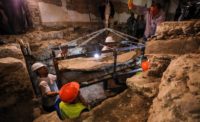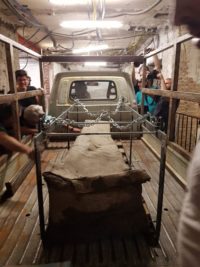 Archaeologists excavating a historic site in downtown Granada unexpectedly discovered a lead sarcophagus from the Roman era. They were excavating under the Villamena building, a modern structure next to Granada Cathedral that was built after a 14th century building on the site was demolished in 1938. Under the Nasrid dynasty (1228-1492) Emirate of Granada, it was the Alhóndiga de los Genoveses, a warehouse used by Genoese merchants to store trade goods like silk and sugar. After the Reconquista, their Catholic Majesties turned the building into a prison. It would remain one for four centuries until all the inmates were moved to the new, much larger provincial prison in 1930. Dilapidated and on the verge of collapse, the Alhóndiga was demolished in the last year of the Second Spanish Republic. Only the front gate was left standing. It still stands today, integrated into the modern structure which houses a bank.
Archaeologists excavating a historic site in downtown Granada unexpectedly discovered a lead sarcophagus from the Roman era. They were excavating under the Villamena building, a modern structure next to Granada Cathedral that was built after a 14th century building on the site was demolished in 1938. Under the Nasrid dynasty (1228-1492) Emirate of Granada, it was the Alhóndiga de los Genoveses, a warehouse used by Genoese merchants to store trade goods like silk and sugar. After the Reconquista, their Catholic Majesties turned the building into a prison. It would remain one for four centuries until all the inmates were moved to the new, much larger provincial prison in 1930. Dilapidated and on the verge of collapse, the Alhóndiga was demolished in the last year of the Second Spanish Republic. Only the front gate was left standing. It still stands today, integrated into the modern structure which houses a bank.
When excavations began, therefore, archaeologists expected to find remains from the Middle Ages, at most. They were doing an archaeological survey as required by law before underground construction work. They did find a few minor remains from the Emirate and Christian eras, nothing of particular significance, and decided before the excavation ended to go down a little deeper. Eight feet below the surface under a slab of muddy sandstone, they unearthed a grave. That wasn’t necessarily exceptional in and of itself, but when the slab was removed, head archaeologist Ángel Rodríguez was stupified to see a lead sarcophagus
Rodríguez believes the sarcophagus dates back to the 2nd or 3rd century AD, a time when lead sarcophagi were not at all common. In Andalusia, they were expensive as well as difficult to obtain, because the industry only existed in Córdoba, over 200 kilometers away. “Córdoba is the only place where they made lead sarcophagi,” Rodríguez explains. […]
The lead sarcophagus … weighs between 300 and 350 kilograms, and has the same dimensions of a classic coffin: 1.97 meters long and 40 centimeters high. It is slightly wider at the head (56 centimeters) than at the foot (36 centimeters). On first inspection, Rodríguez says there is no sign of an inscription, but adds that “it still has a lot of clay and sand,” and “we’ll see when we clean it.” The outside of the sarcophagus has already given researchers many insights, and the inside is expected to give many more when it is opened in a few weeks.
It had to have belonged to a wealthy person as lead sarcophagi were extremely expensive even in places where they were made locally. In the 2nd and 3rd centuries, what is now downtown Granada was the countryside outside of the Roman town. The Albaicín district, where the Alhambra is located, was the center of a modest Roman settlement. While it was out of town, there was no cemetery on the site either. The lost river Darro ran through it. Another lead sarcophagus was reportedly found by workers at the site in 1902, but it was looted to nothingness before archaeologists could get there. It’s possible the riverside held some funerary significance for the residents of the Roman settlement and its Iberian founders.
 The sarcophagus is now being cleaned and conserved at the Archaeological Museum of Granada. Researchers are deciding how best to approach opening the coffin with the least amount of damage. A team of anthropologists, restorers and archaeologists will attend the opening to document its contents.
The sarcophagus is now being cleaned and conserved at the Archaeological Museum of Granada. Researchers are deciding how best to approach opening the coffin with the least amount of damage. A team of anthropologists, restorers and archaeologists will attend the opening to document its contents.
Because lead preserves its contents very well, it’s possible the sarcophagus still holds human remains, grave goods, perhaps even textiles which will shed new light on funerary practices of Roman Granada. Any human remains found at the opening will be transferred to the forensic anthropology laboratory at Granada University. The sarcophagus itself and contents will remain in the museum for further study.